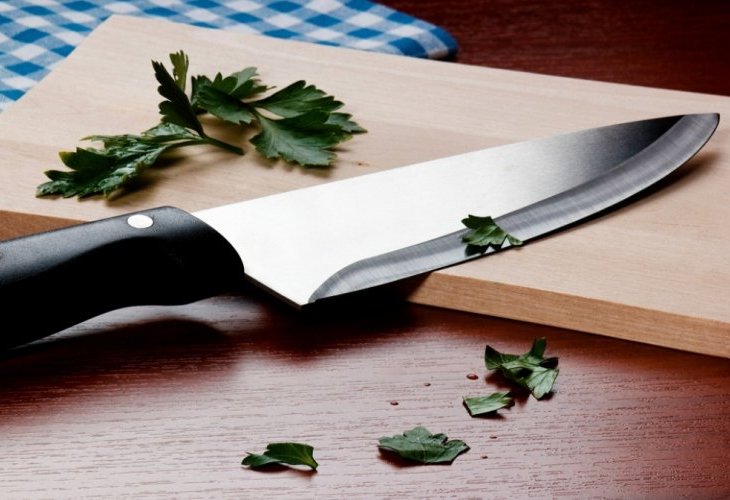Beginners Guide
The Kosher Kitchen: Everything You Need to Know About Knives
Hot cheese souffle and a meaty knife? Chopped onion with a dairy knife for your chicken soup? All this and more in Kosher Knives 101
 (Photo: shutterstock_knife)
(Photo: shutterstock_knife)Knives are some of the more interesting utensils in the kosher kitchen, and the laws related to their use differ significantly from those governing forks, spoons, teaspoons, whisks, spatulas...
Here we present a concise yet comprehensive guide to knives.
Two Knives or Three (or More)?
At minimum, each household needs at least two knives: one for meaty foods, and one for dairy.
Ideally, there should be special bread knives that are used only for bread, to ensure that loaves don't inadvertently become meaty or milky -- because bread is frequently eaten with both meat and dairy meals.
How Does a Knife Become Meaty or Milky?
- A knife becomes meaty or dairy if it came into contact with hot food of either category. "Hot" in this context is called "yad soledet bo," which means at a temperature "from which the hand recoils." This is generally considered to be 110 degrees Fahrenheit (43 degrees Celsius) or more.
- Using a knife with lukewarm or cold food does not confer any status upon it. If it's a new knife, therefore, it remains pareve (neither meaty nor milky).
Meaty Knives with Dairy: Milky Knives with Meat
This shouldn't happen, ideally. But, we're human, so if it does, then...
- If a cold, clean meat/dairy knife was used to cut or spread a cold dairy/meat food item, the item doesn't become non-kosher and may still be eaten. The knife should be thoroughly washed with soap and water.
- If a clean meat/dairy knife was used to cut a hot dairy/meat food item, the food remains permitted for consumption as long as it is at least sixty times bigger than the surface area of the blade of the knife.
- Nonetheless, the area around the cut must be entirely removed -- all the food that came into contact with the blade must be cut away and discarded.
- This applies to hot foods that are still in their original cooking pot or pan, and also to pieces of meat that have been removed from their pot or pan (as they retain a great deal of heat internally).
- For hot dairy foods, and hot meaty foods that do not contain actual pieces of meat, according to the letter of the law the food item remains entirely permissible even if it is not sixty times larger than the area of the blade. However, it is praiseworthy to be strict and only eat the food if it is sixty times larger than the blade area, and also to cut away the area of contact.
The 24 Hours That Make All the Difference
When is a dairy knife not a dairy knife? When it's been out of circulation for over 24 hours. Read on...
- A knife that has been used with hot dairy or meaty food in the past 24 hours is called "ben yomo" (of its day).
- The absorbed taste in such a knife is called "notein ta'am leshvach" (imparting good taste).
- After 24 hours have passed, the knife is "eino ben yomo" (not of its day) and the absorbed taste is considered pagum (spoiled).
- All the above-mentioned halachot concerning hot foods and clean knives relate only to knives that are ben yomo. That doesn't mean that these knives that have seen better days are now considered pareve. They're not, and one should still not mix and match.
The Onion That Saved the Day
- Onions and all other "pungent" foods (such as garlic, radish, lemon, and salted fish) have a special quality. When cut with a knife, their pungency actually extracts some of the substance absorbed in the knife's blade. Not just the "taste" in the knife but some of the physical substance leaves the knife and enters the food.
- If a ben yomo dairy (or meat) knife is used to cut a pungent food, the pungency combined with the pressure of the blade forces the absorbed dairy (or meat) in the blade to enter the food, even if everything is cold.
- Therefore, if you used a ben yomo dairy knife to cut a slice out of an onion, and then want to use the rest of the onion in your chicken soup, you must first cut off a finger's width around the area touched by the blade. This cutaway area can be eaten with dairy (not meat); the rest of the onion can be added to your meaty soup.
- There is a halachic dispute regarding whether pungent foods can also "rejuvenate" the "good taste" in a knife (or other utensil) which is not ben yomo. Therefore, it is preferable to follow these rules for knives and pungent foods regardless of when the knife was last used.
- If a treife knife (one that was used with hot non-kosher food) is used to cut a pungent food such as onion, all halachic authorities agree that the food is prohibited, even if the knife has not been used at all in the past 24 hours.
Congratulations! You completed Kosher Knives 101.

